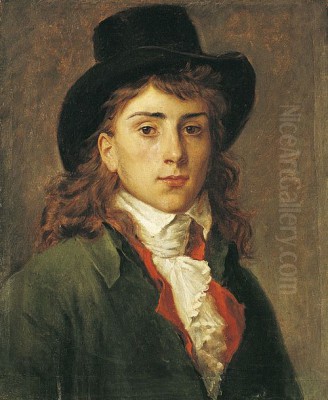
Antoine-Jean Gros stands as a pivotal figure in French art history, an artist whose career was inextricably linked with the meteoric rise and dramatic fall of Napoleon Bonaparte. Born in Paris on March 16, 1771, into an era of profound social and political upheaval, Gros navigated the turbulent waters of the French Revolution, the Napoleonic Empire, and the Bourbon Restoration, leaving behind a legacy of powerful, often propagandistic, yet artistically innovative works. He was a student of the great Neoclassicist Jacques-Louis David, yet his own artistic temperament leaned towards the burgeoning Romantic movement, making him a crucial bridge between two dominant artistic sensibilities. His canvases captured the dynamism, glory, and suffering of his time, influencing a generation of artists who would fully embrace the Romantic ethos.
Early Life and Artistic Formation under David
Antoine-Jean Gros's artistic journey began under the tutelage of his father, Jean-Antoine Gros, who worked as a painter of miniatures. This early exposure instilled in him the fundamentals of drawing and painting. However, his formal and most significant training commenced in 1785 when, at the age of fourteen, he entered the prestigious studio of Jacques-Louis David. David was the undisputed leader of the Neoclassical movement in France, championing a style characterized by compositional clarity, linear precision, sober colors, and morally uplifting themes drawn from classical antiquity and republican virtue.
In David's studio, Gros absorbed the rigorous discipline of Neoclassical drawing and composition. He learned alongside other talented pupils who would also make their mark, such as Anne-Louis Girodet de Roussy-Trioson and François Gérard. David's emphasis on historical accuracy, anatomical precision, and the didactic potential of art profoundly shaped Gros's approach. Yet, even during this formative period, Gros displayed an innate attraction to color and dramatic effect that hinted at a departure from his master's stricter doctrines. He also attended classes at the Académie Royale de Peinture et de Sculpture, further honing his skills.
The Revolutionary Upheaval and Italian Sojourn

The outbreak of the French Revolution in 1789 dramatically altered the course of French society and Gros's own life. The political turmoil and the Reign of Terror created a dangerous environment, particularly for those perceived to have royalist sympathies, a suspicion that fell upon Gros. Furthermore, the death of his father added to his financial difficulties. Seeking safety and opportunity, Gros left France in 1793, making his way to Italy, the traditional destination for aspiring artists seeking to study the masters of the Renaissance and Antiquity.
He initially settled in Genoa, later moving to Florence. During this period, he supported himself primarily by painting portraits and miniatures, developing his skills in capturing likenesses and refining his handling of paint. Italy proved crucial not only for his survival but also for his artistic development. He immersed himself in the works of the Italian masters, particularly the Venetian school painters like Titian and Veronese, and the Flemish Baroque master Peter Paul Rubens, whose dynamic compositions and rich, vibrant use of color resonated deeply with his own inclinations, offering a powerful counterpoint to the linear austerity of Davidian Neoclassicism.
Encounter with Napoleon and the Dawn of a New Era
A pivotal moment occurred in Genoa in 1796. Through his acquaintance with Joséphine de Beauharnais, the wife of the rising military star General Napoleon Bonaparte, Gros was introduced to the future Emperor. Napoleon was then leading the French army in his brilliant Italian campaign. Impressed by the young artist, Napoleon commissioned Gros to paint a portrait commemorating a key moment of bravery: his leading the charge across the bridge at the Battle of Arcola.
This commission resulted in one of Gros's first major masterpieces, Bonaparte at the Bridge of Arcola (1796). The painting broke new ground. While retaining a degree of Neoclassical structure, it pulsated with energy and movement. Gros depicted Napoleon not as a static, classical hero, but as a dynamic leader, flag in hand, turning dramatically towards his troops (and the viewer), embodying courage and action. The looser brushwork and emphasis on capturing a fleeting, heroic moment signaled Gros's burgeoning Romantic sensibility and instantly captured Napoleon's imagination.
Official Painter of the Napoleonic Epic
The success of Bonaparte at the Bridge of Arcola cemented Gros's relationship with Napoleon and launched his career as a premier painter of the Consulate and later the Empire. He was appointed to Napoleon's staff, accompanying the army on campaigns and witnessing firsthand the events he would later depict. He became an official chronicler of Napoleonic glory, tasked with creating large-scale history paintings that celebrated the Emperor's military victories and political achievements.
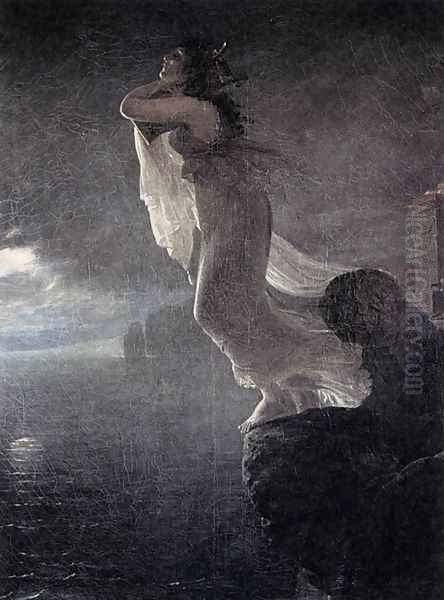
These commissions were often explicitly propagandistic, designed to shape public perception and legitimize Napoleon's rule. Gros excelled in this role, creating vast, dramatic canvases filled with action, pathos, and heroic portrayals of the Emperor. He received numerous honors, including the Legion of Honour in 1808, and his works were prominently displayed at the official Salons, garnering widespread acclaim and solidifying his reputation. He effectively became the visual narrator of the Napoleonic legend.
Masterworks of the Empire: Glory, Suffering, and Propaganda
Gros's period as Napoleon's painter produced his most famous and influential works. These paintings are characterized by their grand scale, dramatic compositions, rich color palettes, and a complex blend of heroic idealization and startling realism, particularly in the depiction of suffering.
Napoleon Visiting the Plague Victims at Jaffa (1804)
Perhaps Gros's most iconic and complex work, this painting depicts an episode from the Egyptian campaign where Napoleon visited his plague-stricken soldiers in Jaffa. Commissioned to counter rumors that Napoleon had ordered the execution of these soldiers, the painting is a masterful piece of propaganda. Napoleon is shown in the center, bathed in light, fearlessly touching the sores of a sick soldier, presented almost as a Christ-like healer. The setting is exotic, the suffering of the soldiers depicted with unflinching realism, contrasting sharply with the idealized figure of the Emperor. The painting's rich colors, dramatic lighting, and focus on contemporary suffering and exoticism had a profound impact, notably influencing later Romantic painters like Théodore Géricault and Eugène Delacroix.
The Battle of Aboukir (1806)
This tumultuous canvas captures the French cavalry charge led by Joachim Murat against Ottoman forces during the Egyptian campaign. It is a whirlwind of action, color, and violence, showcasing Gros's ability to handle complex, multi-figure compositions and convey the chaotic energy of battle. The swirling movement, the clash of arms, and the exotic costumes contribute to its dramatic intensity, further establishing Gros's departure from the static compositions often favored by Neoclassicism.
Napoleon on the Battlefield of Eylau (1808)
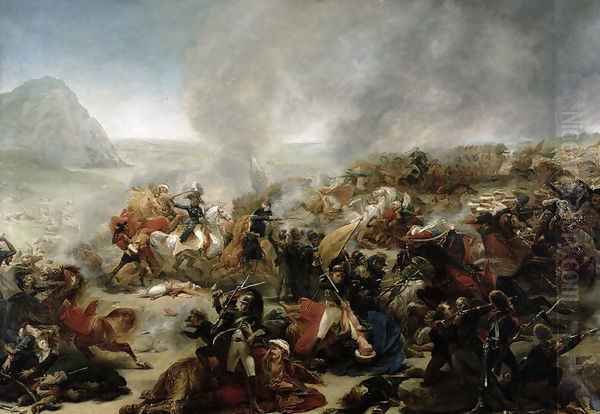
Commissioned after a competition, this painting depicts Napoleon surveying the horrific aftermath of the bloody Battle of Eylau, fought against the Russians and Prussians in harsh winter conditions. Unlike the heroic charge at Arcola, Eylau confronts the grim reality of war. The vast canvas is dominated by a snow-covered landscape littered with the dead and dying. Napoleon, mounted on horseback, gestures compassionately towards the suffering soldiers, both French and enemy alike. While still presenting Napoleon in a favorable light as a humane leader, the painting's stark depiction of the cost of war, its atmospheric rendering of the cold, bleak setting, and its focus on collective suffering mark it as a significant step towards Romantic realism.
Portrait of Lieutenant Charles Legrand (c. 1810)
While known for grand history paintings, Gros was also a skilled portraitist. This work exemplifies his ability to capture individual character and presence. Legrand is depicted with a confident yet introspective air, set against a dramatic sky. The brushwork is fluid, and the attention to the textures of the uniform and the sitter's features demonstrates Gros's versatility.
Portrait of General Fournier-Sarlovèze (1812)
Exhibited at the Salon of 1812, this portrait depicts the famously difficult general with a striking immediacy and confidence. Standing against a windswept landscape, Fournier-Sarlovèze embodies the military prowess and perhaps the arrogance of Napoleon's officers. Gros uses bold brushwork and strong contrasts to convey the subject's forceful personality.
Artistic Style: Bridging Neoclassicism and Romanticism
Antoine-Jean Gros occupies a fascinating position in the stylistic evolution of French art. Trained by the arch-Neoclassicist David, he never fully abandoned the principles of strong drawing and structured composition learned in his master's studio. His large history paintings often retain a sense of order and clarity derived from Neoclassical ideals. However, his artistic temperament and the nature of his subject matter—contemporary history, warfare, exotic locales, intense human emotion—pushed him towards Romanticism.
His key deviations from strict Neoclassicism included:
Emphasis on Color and Light: Inspired by Rubens and the Venetians (Titian, Veronese), Gros employed a richer, more vibrant color palette and dramatic chiaroscuro (contrasts of light and dark) to heighten emotional impact and create atmosphere. Color, rather than line, often became the primary vehicle for expression.
Dynamism and Movement: Unlike the often static, frieze-like compositions of David, Gros's battle scenes and historical moments are filled with energy, swirling action, and dramatic gestures.
Emotional Intensity: Gros did not shy away from depicting intense emotions – courage, fear, suffering, compassion. His figures are often imbued with a psychological depth and pathos that transcends Neoclassical restraint.
Contemporary Subject Matter: While David increasingly focused on ancient history and mythology, Gros became the foremost painter of contemporary events, lending an immediacy and relevance to his work that resonated with the public.
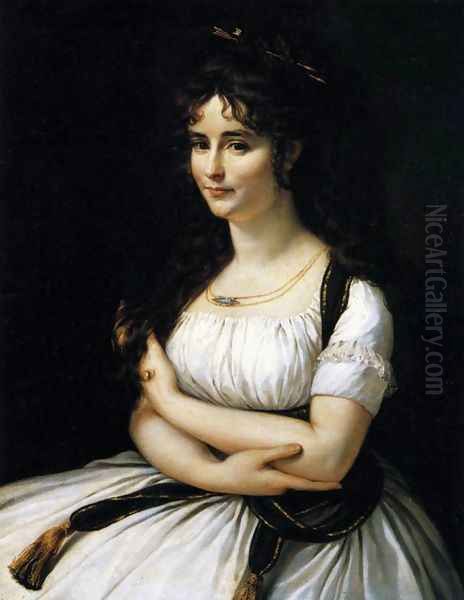
Exoticism: His paintings set in Egypt and the Near East (Jaffa, Aboukir) introduced exotic settings, costumes, and themes that became hallmarks of Romantic art.
He can be seen as a transitional figure, incorporating the dynamism and color of the Baroque (specifically Rubens) into a framework still partially informed by Neoclassical structure, paving the way for the full-blown Romanticism of Géricault and Delacroix. His work stands in contrast to the cool linearity of contemporaries like Jean-Auguste-Dominique Ingres, another David student who adhered more strictly to Neoclassical principles.
The Later Years: Restoration, Disillusionment, and Tragedy
The fall of Napoleon in 1814-1815 marked a turning point in Gros's fortunes. His primary patron was gone, and the political climate shifted dramatically with the Bourbon Restoration. While Jacques-Louis David was forced into exile for his revolutionary activities, Gros remained in Paris. He inherited the leadership of David's influential teaching studio and attempted to adapt to the new regime. He continued to receive official commissions, including portraits of the restored Bourbon monarchy, such as Louis XVIII, and significant decorative projects.
One of his most ambitious later works was the decoration of the dome of the Panthéon in Paris, depicting The Apotheosis of Saint Genevieve (completed 1824). This vast undertaking, while demonstrating his technical skill, saw him attempting to return to a more purely Neoclassical style, perhaps seeking favor with the new establishment or adhering to the perceived dictates of grand public art. In recognition of this work and his status, Charles X made him a Baron in 1824.
However, Gros found himself increasingly out of step with the evolving art world. The Romantic movement, which he had helped to inspire, was now in full swing, led by younger artists like Delacroix. His attempts to embrace a stricter Neoclassicism in his later history paintings were often criticized as cold, academic, and lacking the vitality of his earlier Napoleonic works. He felt alienated from the younger generation and perhaps burdened by the legacy of his exiled master, David, whose artistic principles he tried, somewhat uncomfortably, to uphold in his teaching.
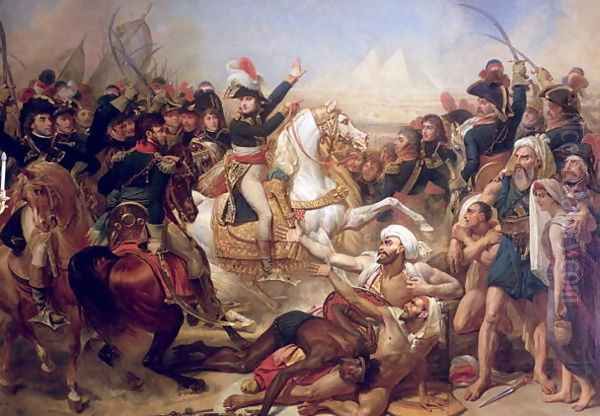
The criticism, coupled with personal difficulties and perhaps a sense of profound disillusionment with the trajectory of his own art and the changed political landscape, took a heavy toll. Feeling increasingly isolated and artistically irrelevant, Antoine-Jean Gros tragically ended his own life. On June 25, 1835, his body was found drowned in the Seine near Meudon. A note found in his hat spoke of being "weary of life" and betrayed by his "last faculties" which rendered it "unbearable."
Influence and Legacy
Despite the tragic end to his life and the critical decline in his later years, Antoine-Jean Gros's historical importance and artistic influence are undeniable. He stands as one of the most significant painters of the Napoleonic era, his works providing a vivid, if often idealized, visual record of that tumultuous period. His major Napoleonic canvases remain iconic images of the Emperor and his campaigns, housed in major collections like the Louvre and Versailles.
His crucial role lies in his position as a bridge between Neoclassicism and Romanticism. While indebted to David, his emphasis on color, emotion, movement, and contemporary history directly paved the way for the next generation. Eugène Delacroix openly acknowledged Gros's influence, particularly citing the emotional power and painterly qualities of works like Jaffa and Eylau. Théodore Géricault's Raft of the Medusa, a seminal work of Romanticism, shares with Gros's paintings a focus on contemporary tragedy, dramatic composition, and the realistic depiction of suffering.
His studio trained or influenced numerous artists, including the American portraitist George P.A. Healy and, arguably, figures like Richard Parkes Bonington and Paul Delaroche absorbed aspects of his approach to history painting. While some contemporaries like François Gérard navigated the political changes more smoothly, and others like Ingres championed a rival aesthetic, Gros's unique blend of Neoclassical training and Romantic sensibility carved out a distinct and influential path.
Conclusion: A Painter Caught Between Eras
Antoine-Jean Gros's life and art reflect the dramatic era in which he lived. He rose to prominence as the favored painter of Napoleon, capturing the energy and ambition of the Empire in canvases that pulsed with color and drama. He masterfully balanced the demands of official propaganda with genuine artistic innovation, pushing the boundaries of Neoclassicism towards the emotional intensity and visual richness of Romanticism. His works like Napoleon Visiting the Plague Victims at Jaffa and Napoleon on the Battlefield of Eylau remain powerful statements, not just about Napoleon, but about human suffering, heroism, and the complex realities of war.

Though his later career was marked by a struggle to adapt and a sense of artistic isolation, leading to a tragic end, his legacy endures. He was a vital link in the evolution of French painting, a master technician whose bold use of color and dramatic compositions inspired the leading figures of the Romantic movement. Antoine-Jean Gros remains a compelling figure, an artist whose brush chronicled the epic sweep of Napoleonic history while simultaneously heralding the dawn of a new artistic age.